“We have this wonderful state trail that has precisely one chunk that is completely inaccessible to many of the folks in our community.”
— Arthur Babitz, advisory committee member
There’s only section of the 73-mile long Historic Columbia River Highway State Trail between Troutdale and The Dalles that isn’t accessible to everyone: a huge staircase in Cascade Locks near the Eagle Creek trailhead.
The stairs pose an insurmountable barrier to some people with disabilities. For riders on adaptive bikes, tandems, bikes pulling cargo trailers — and anyone who can’t easily carry themselves or their chosen vehicle down stairs — they’re a major challenge and pose serious risks.
After years of complaints and even the threat of a lawsuit from cycling and disability rights advocates, the Oregon Department of Transportation is taking steps to rectify this glaring oversight on an otherwise stellar piece of cycling-friendly infrastructure.
Advertisement
(Photo: J. Maus/BikePortland)
At the December 17th meeting of the Historic Columbia River Highway Advisory Committee, consultants presented the first-ever conceptual renderings of a viaduct that would smooth out the stairs once and for all. It was part of a scoping exercise completed pro bono for the nonprofit Friends of the Historic Columbia River Highway.
The stairs were built when the State Trail first opened in 1996. That was several years before ADA mandates for recreational facilities were in place.
“The reason why we’re looking at this is that the stairs were built very early in the life of this project,” said advisory committee chair Arthur Babitz at a meeting last month. “And we are now quite aware that we have this wonderful state trail that has precisely one chunk that is completely inaccessible to many of the folks in our community. So the challenge here is to look for a design solution as well as funding to correct this error that was made early in the project.”
Advertisement
“I want to make sure we’re keeping our priorities straight.”
— Rian Windsheimer, ODOT Region 1 Director
ODOT says replacing the stairs has long been a priority, but completing the state trail has taken precedence.
A 2019 Willamette Week story reported how some bicycle riders with disabilities had threatened a lawsuit over the stairs. When ODOT re-opened the state trail in August 2019 following the Eagle Creek wildfire, activists showed up to highlight their concerns.
ODOT plans to use the new scoping report in a federal grant application to replace the stairs (in 2009 the project was estimated to cost around $2.5 million).
ODOT’s Region 1 Manager Rian Windsheimer and ODOT Columbia River Gorge National Scenic Area Coordinator Terra Lingley are trying to tamp down expectations.
“We’ve said it’s a priority for us to get this fixed at some point in the future, but our priority is the trail and completing it first…,” Windsheimer said. “I want to make sure we’re keeping our priorities straight.”
Advertisement
Lingley added in an email to BikePortland that, “The final product may or may not align with what they shared at the meeting… there is still much work yet to be done.”
One issue appears to be how the ramp would look. There were several concerned references to how the project must align with the Columbia River Gorge National Scenic Area Act.
A rep from the US Forest Service (the agency that would have to co-sign any federal grant) said at the meeting that, “We totally support accessibility and making this work. And we also really want to make sure we’re considering the Scenic Act and the impacts to cultural resources and scenery.”
The proposed design at this point would demolish the existing stairway and replace it with a ramp that would have a gradient of 5% or lower. The advisory committee has listed the project on their 2021 work plan and ODOT plans to submit the federal grant application by this coming April. Stay tuned.
— Jonathan Maus: (503) 706-8804, @jonathan_maus on Twitter and jonathan@bikeportland.org
— Get our headlines delivered to your inbox.
— Support this independent community media outlet with a one-time contribution or monthly subscription.


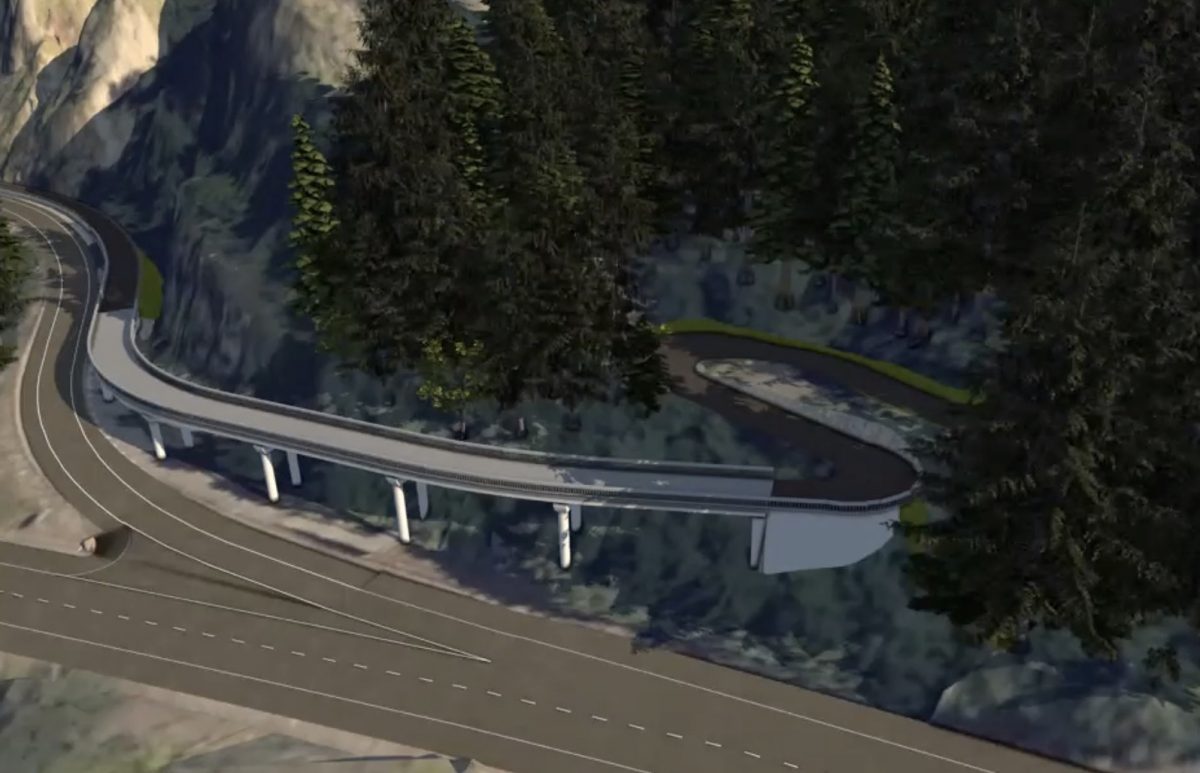
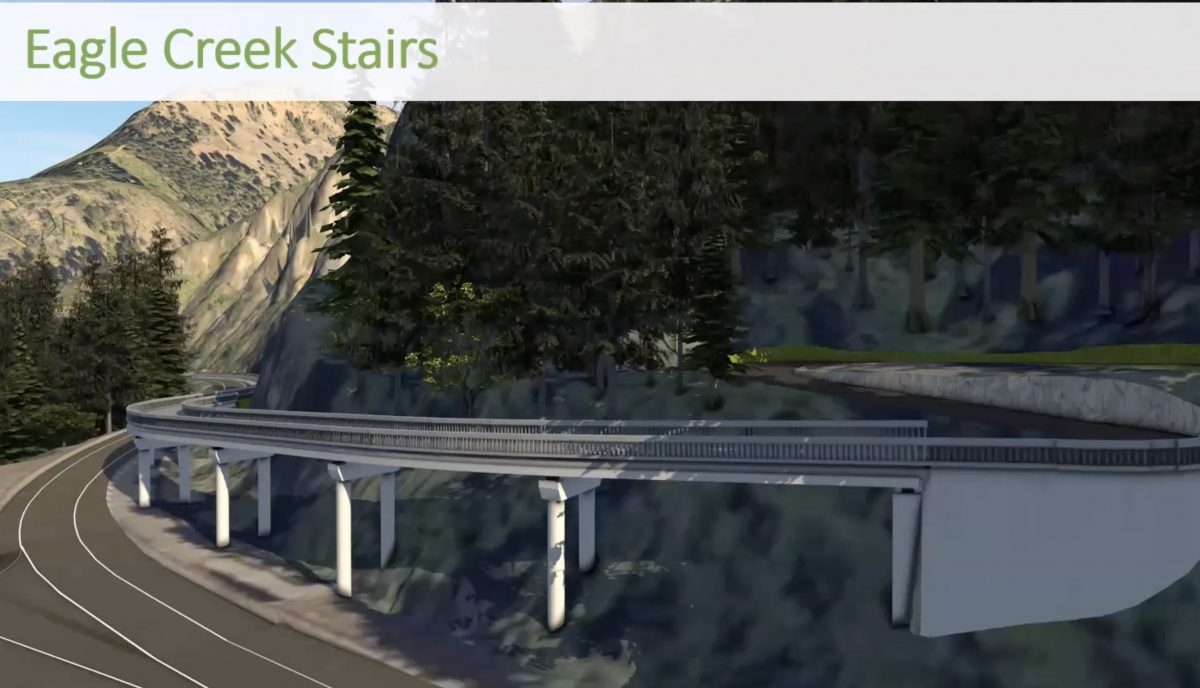
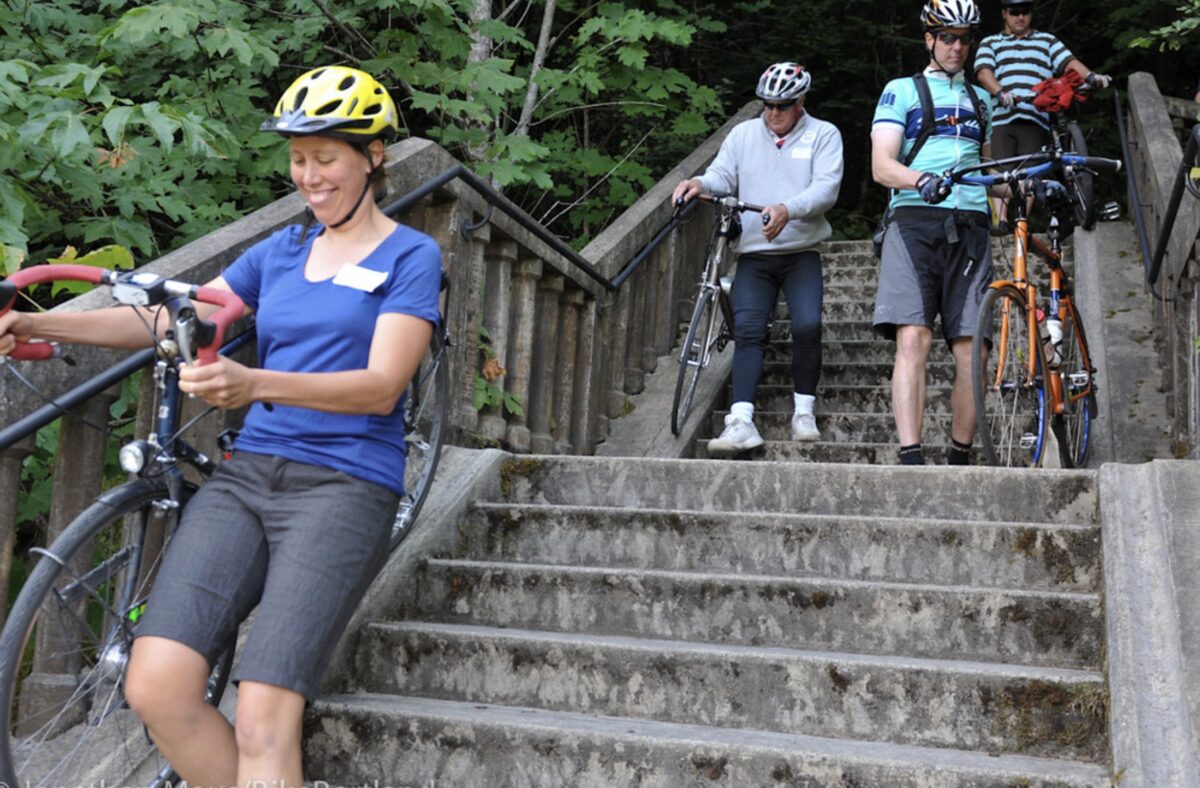

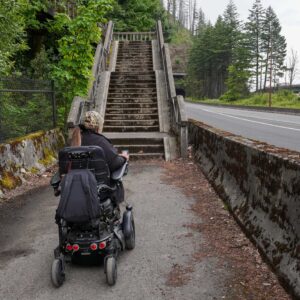
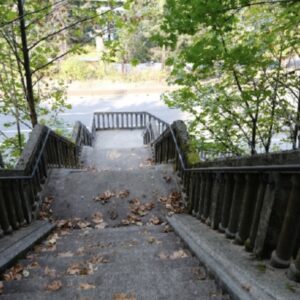

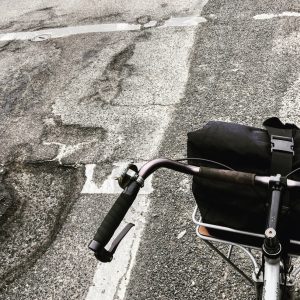
Thanks for reading.
BikePortland has served this community with independent community journalism since 2005. We rely on subscriptions from readers like you to survive. Your financial support is vital in keeping this valuable resource alive and well.
Please subscribe today to strengthen and expand our work.
It will make a huge difference to me to be able to bike this route in the future without relying on porters (my able friends). Thank you, ODOT.
This is great to see, as it’s currently a gigantic barrier in what is otherwise an amazing route, especially since the only alternate route is through the I-84 tunnel that I would never even think of riding through. With this, it will be easily possible to bike from Portland to the Eagle Creek, Herman Creek, Wyeth, Starvation Creek, and Viento areas, as well as Cascade Locks, and enjoy the recreation opportunities in these areas without a car. And even all the way to Mitchell Point, Hood River, and The Dalles once the final section is also completed.
Kudos to ODOT on this one. Their explanation of wanting to complete the entire trail before seeking funding to fix this part seems like an eminently believable and reasonable reason for the delay.
Better late than never, I suppose, but remember: the ADA became law in 1991. The stairs were built five years LATER. Even if reasonable access requirements weren’t in place at the time, ODOT knew that accessibility was now a national priority, but evidently chose instead to invest in inequality ,denying access to a national treasure to many Oregonians and visitors for at least a quarter century. Reminds me of the oil companies and others today scrambling to get their polluting projects and bids in before climate change rules change, sticking future generations with the consequences even though they knew times were changing. Maybe there’s a more innocent explanation, but would be nice to know why ODOT made the unjust decision it did, regardless of what the letter of the law – vs the needs of all Oregonians, not just some – required. Instead of thanking ODOT for fixing – at legal gunpoint – a problem it created, let’s thank the hard working disability rights advocates that forced it to do the right thing it should have done in the first place.
According to the ODOT bike/ped manager at the time (Michael Ronkin, who commented on this story over on our FB page), they were well aware of the ADA issues, but, “At the time, the choice was stairs or no project. So within that context, the stairs made sense.”
I see. “Sure, your taxpayer financed school can have water fountains –but only white people can use them. Do you want water fountains or not? Take it or leave it.” If that’s the “choice” ODOT presented, or accepted, they’re just as guilty of discriminating against people with disabilities. The ADA established access as a civil right, not a budget convenience.
I haven’t rode the gorge path that far but in my car I have looked over and wondered if that was the bike path. The staircase has always looked so out-of place. Glad to see this will be fixed. I have dreams of riding out to Hood River and beyond once this is finished.
Those stairs are the worst. Cleat killers!
I’m soooooo excited about this project! Let’s hope the funding comes through sooner rather than later. This will remove a very significant barrier that has stood for far too long in the Gorge.
Considering that several people have died riding on the section west of Hood River where no trail is present, I think I actually agree with ODOT’s position to prioritize that section before rebuilding existing sections. I don’t think anyone has died on these stairs.
YAY!…its even a barrier for able bodied touring cyclists (like me)…especially in the uphill direction. Universal Design, yep yep!!
[And its great to hear that Michael is still reading BikePortland all the way in Europe!]
I hate to be contrarian, but I kinda like those stairs. Yes, you have to strip your bike of gear and haul it down but there is a runner for the wheals of the bike. It’s just a different feature on this long ride out to Viento Park and it adds interest to the ride.
I have very mixed feelings about this. ODOT needs to ease off on doing major projects and devote the resources to keep existing resources functioning correctly.
You all have probably noticed the lighting upgrades. ODOT did the upgrades that involve use of contractors, bids, and those things as it will. They put in flashy looking lights and associated PR stunt. Despite having been at the poles, they completely ignored the criminal mischief damage caused to the poles and ignored the illegal spices, missing covers caused by electricity thieves.
I don’t understand why you wouldn’t correct those deficiencies at the same time. Clearly they’re more interested in shiny new projects than anything else. They’re doing what real estate investors lipstick renovation.
As a disabled cyclist who rides a trike and also uses other mobility devices, This is great to see! More than 30 years after the ADA…I remember hearing talk a few years ago about fixing the Historic Columbia River Highway State Trail, but the talk seemed to just die away. I have never ridden this trail, since it was inaccessible to me in many ways. I look forward to actually being able to ride it someday.
Do you feel that this is more important, or maintain existing amenities to be usable for their intended purpose? A lot of ODOT maintained paths are significantly impaired due to detritus, junk and hostile infestation by activities that are not intended use.
More important? No. Fixing and maintaining their existing infrastructure should be a top priority. At the same time this is something that should have been done years ago.
Of there was a set of stairs on a road, odot would use “emergency funding” to fix it. But Instead, odot will take years to put in a ramp. Wow.
They *might* fix it. After a few years of squabbling over whether that road road was their responsibility, or PBOT’S responsibility. But only if you sent in a request, and it hit the right person’s desk, at the right time of year.
Two years ago, I looked into the history of why the stairs were built well after the ADA made it illegal for public entities to discriminate in the design of new construction, which the Eagle Creek stairs were. The ADA made it clear that an accessible route must not include stairs, so what happened? Each segment of the trail on either side of the Eagle Creek stairs was made fully accessible. I found that planners considered but rejected doing the engineering/approval work for an accessible structure to link the two segments. The stairs were much cheaper. The project could be completed within budget with stairs they wrote. To make matters worse, we see from the terrible design of the stairs they forgot about safety and access standards for the stairs. I discerned also that stereotypes about people with disabilities were a factor. The master plan suggested that people with disabilities could get access by driving around them, a ridiculous notion then and now. Anyway, it’s great that the State of Oregon realizes the problem finally. But let’s not forget that the ADA requires the Department of Parks to offer people with disabilities an accommodation so that they can use and enjoy the trail. We requested accommodations be devised and publicized and we are still waiting. Among our suggestions were that a shuttle of some sort be provided on request. We have heard nothing. Concerning the announcement that the priority has to be to complete the trail before addressing the stairs, in the absence of any accommodations to provide access, this is an announcement they will continue to intentionally discriminate.
I left a comment and it does not seem to be published. Please get in touch with me. I would like to know the reason and see what can be done. Thanks.